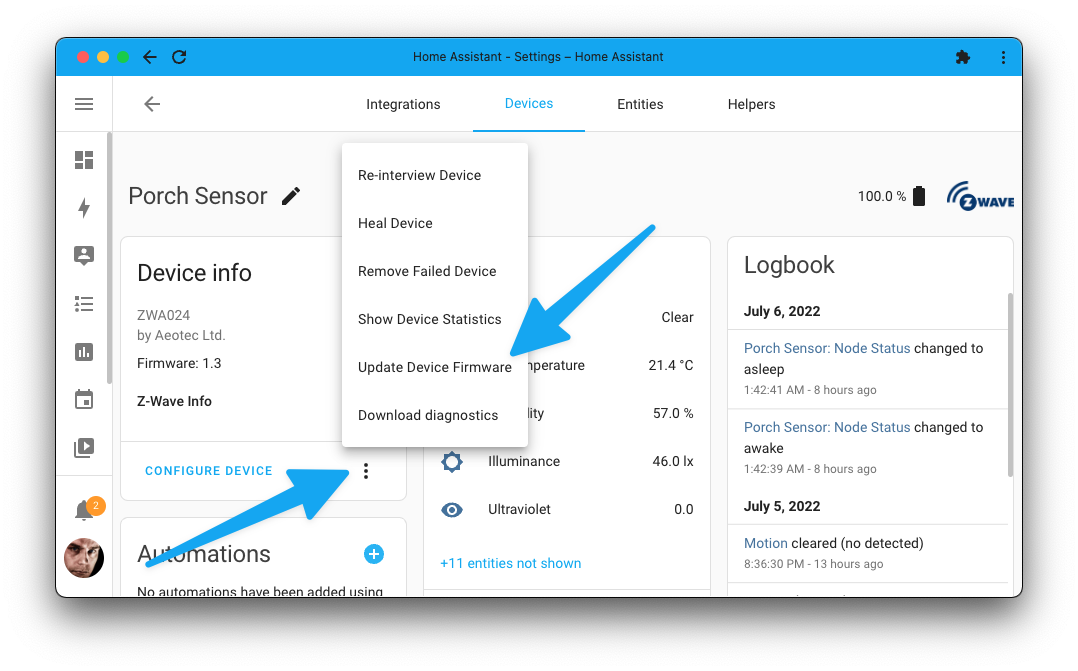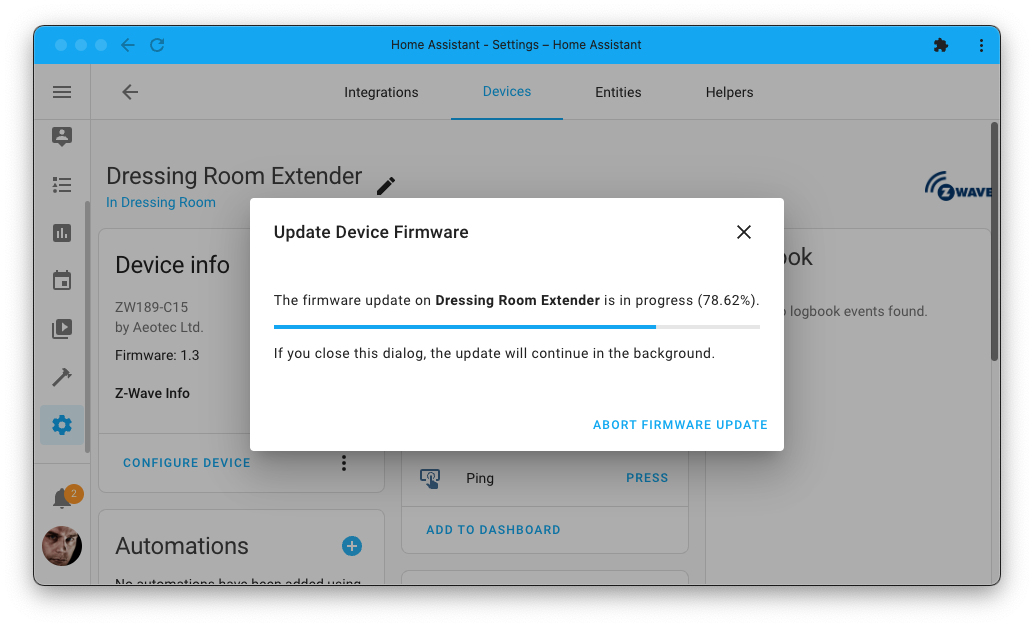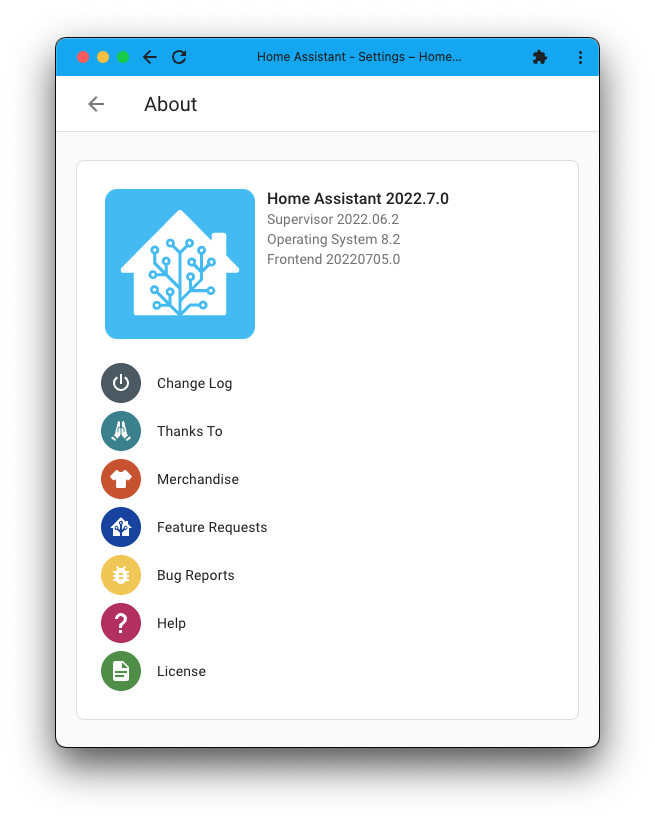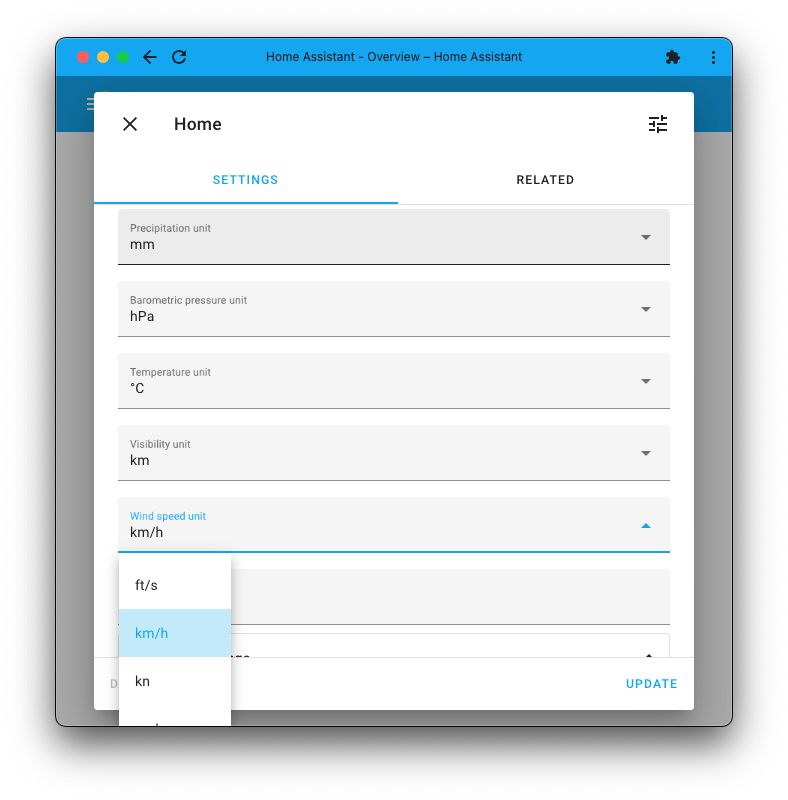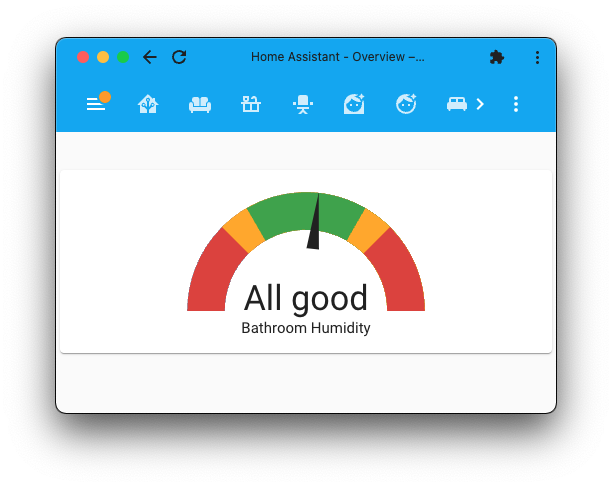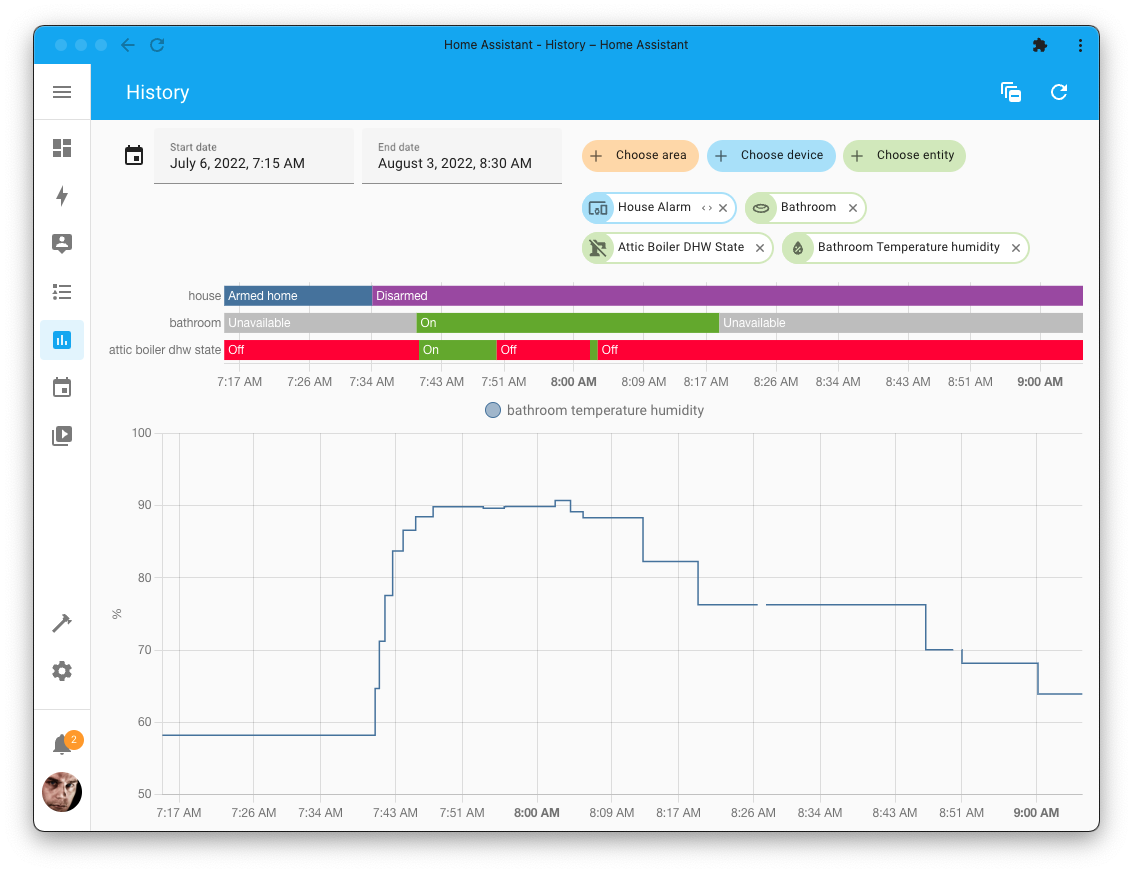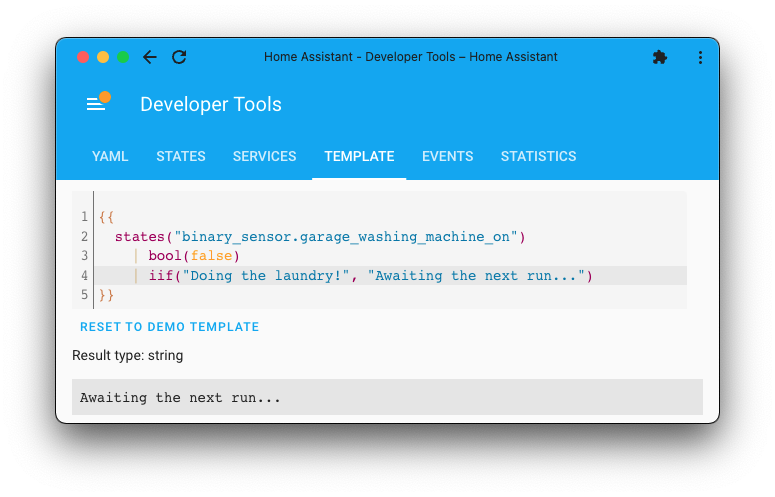Home Assistant Core 2022.7! ☀️
This was one exciting and busy month! In case you’ve missed it, there was
a Matter in Home Assistant workshop
and a Let’s get loud! event
about bringing audio to the Open Home.
If you have missed those, it is worthwhile to check those recordings out.
Meanwhile, preparations are happening for the upcoming Matter and of course,
the soon-to-be-released Home Assistant Yellow! 💛 More about that soon™.
This release is definitely representing the “streamlining experiences”
motto we have been using. The performance improvements in this release are
once more: stunning! Furthermore, there are some wonderful new features to
explore too.
This release has the perfect mix! I’m sure there is something in here you
like. So without further due: Enjoy the release!
../Frenck
Don’t forget to join our release party live stream on YouTube today at 12:00 PDT / 21:00 CET!
Índice
Improved stability and performance, and Python 3.10
The quest to improve the performance of Home Assistant continues. For many
releases, @bdraco has been analyzing every single aspect of
Home Assistant and manages to make it faster every single release.
Usually, we have a section at the end of our release notes informing you
about the performance improvements made. The improvements in this release,
however, are a big deal.
Our YAML & JSON tooling improved, using faster libraries and methods.
JSON is used internally and for communication with the frontend, which is
A LOT snappier now. If you use lots of YAML, you will undoubtedly notice this
when starting Home Assistant or reloading things like your automations 🚀.
Devices with an integration error during startup that can self-recover
will now do that instantly as soon as the device is discovered.
We now use a better and faster encryption method for the HomeKit Accessory
Protocol (HAP). It improves the performance of the HomeKit, HomeKit Controller,
and Apple TV integrations and prepares Home Assistant for iOS 16.
Lastly, @pvizeli has been working hard to ship Home Assistant on Python 3.10!
Which also brings quite a performance improvement. If you run the Home Assistant
Operating System or use our container installation method, you will
automatically get this; there is no need to do anything. 🚀
Update Z-Wave devices directly from Home Assistant
All software has bugs, including the software on your Z-Wave devices. But how
to update those? Have no fear! As of today, we have a solution for this!
Thanks to the hard work and collaboration between @AlCalzone from Z-Wave JS
and @raman325 from Home Assistant, you can now install updates on your
Z-Wave devices directly from the Home Assistant interface!
On the device page of your Z-Wave device, there is now a menu item allowing
you to install Z-Wave firmware updates onto your device manually.
Get a software update for your Z-Wave device from the manufacturer,
and start an update in Home Assistant, which allows you to upload the
update file you got from the manufacturer. The rest is pure magic!
During update installation, you’ll be presented with the update’s progress.
It is that easy 💪
The about page is now beautiful too!
Have you ever looked at the about page in the Home Assistant settings menu?
It was probably one of the least visually appealing pages still in our menus,
and @zsarnett seemed to agree. He made it a lot more cleaner and functional.
It now clearly shows the versions of the different components your instance is
made up of, and provides a clean menu to all kinds of Home Assistant related
links.
Change any weather unit to your preference
Home Assistant has many weather services that can be integrated; it is
great to have a choice! The differences between those are often their
accuracy for your region and the units of measurement used for the
different weather data points.
But what if you’d like the barometric pressure unit to be in mbar instead of
hPa? Or maybe use m/s or knots instead of km/h for wind speed? No problem!
You can now change the units each weather entity uses! Not just temperature,
but for all of the values a weather entity provides. When changing a unit,
Home Assistant will take care of converting the values for you.
As a bonus, this same unit-changing feature is added to the number entities
that represent a temperature. For those number entities, you can now change
the units from Celsius to Fahrenheit (and the other way around).
Thanks @emontnemery and @gjohansson-ST for adding this and updating
all existing weather integrations to support this 👍.
Labels instead of values for gauge cards segments
When displaying an entity gauge card on your dashboard, it would show the
gauge with the sensor value. For example, if you’d use a humidity sensor,
it shows the humidity percentage in the middle of the gauge.
In the 2022.5 release, we added segment support to our gauge card.
In this release, @kristjanbjarni added label support to those segments!
This means that if your segment has a label, the gauge card will show
that label instead of the sensor value when it is in that range.
For more information, check out our gauge card documentation.
Code editors now auto-complete MDI icons
All of our code editors in the frontend now have auto-completions for
MDI icons. Just start typing mdi: and it will help you find the exact icon
you need.
Like the normal icon picker, it supports searching on parts of the icon
name, its aliases and categories. Additionally, it will show a little preview
of the icon you are about to select, so you know you got the right one.
Thank you @bramkragten, this is a really nice addition!
Filter the history panel
If you have lots of devices and entities then the
history panel can be long! Actually,
it would become so large, that it becomes unpractical. You could always
filter it down to a single entity, but that is fairly limited as well.
For this release, @D3v01dZA improved these filters.
The history can now be filtered by one or more entities, by all entities of
one or more areas, or by all entities of one or more devices.
This is super helpful, as you can now view the history of all entities in,
for example, your living room area quick and easy.
Easily convert values to booleans in templates
If you are into templates, @pyos has a surprise for you: We now have a bool
function that can be used as a filter too!
If you are a bit into coding, this is not the standard bool(), but one that
is very specific for Home Assistant, making it very useful.
This bool method converts a value into a boolean and considers
Home Assistant’s specific rules for truthy values. Some examples: "on" will
be considered true, and "disabled" will be considered false.
Using bool as a filter and combined with and iif
filter, you can quickly change, for example, binary sensors values into any
text you’d like.
For more information, check out our Templating documentation.
Other noteworthy changes
There is much more juice in this release; here are some of the other
noteworthy changes this release:
- The Material Design Icons have been updated to v6.9.96, giving you
100 and another
100 brand new icons
to use 🤩 . - You can now control the loudness and various additional surround-related
settings of your Sonos speakers, thanks @jjlawren! 🔊 - You can now trigger Alexa routines from switches, toggles, and buttons
without the need to wrap them into a binary template sensor first.
Fantastic addition, @mdegat01! - The logbook live feeds will now automatically pause when you start
scrolling and resume when you are back at the top again. Thanks, @bdraco! -
@matrixd2 extended YoLink; It now supports thermostats, valve controllers,
locks, and vibration, CO, and Smoke Sensors! - Jellyfin now supports movie collections in the media browser, thanks @j-stienstra!
- Thanks to @dmulcahey, the widely discussed Aqara FP1 sensor is now
supported by ZHA! -
@ghedo has been busy improving the Area Card. It can now show
moisture/flood alerts, humidity, and shows an icon for temperature. Nice! -
@king444 added support for Top/Down, Bottom/Up to Hunter Douglas PowerView.
Additionally, buttons to calibrate and jog (identify) have been added. @bdraco
added support for polling in case the device is mains powered. - Thanks to @thrawnarn, you can now send polls via Telegram bot!
- The Home Connect integration now has whole collection of new services
that can be used to control and configure options of device programs.
Really nice, @BraveChicken1! - If you have WiZ power plugs with power monitoring, these are now supported,
thanks to @bdraco ⚡️. -
@gjohansson-ST added lots of love to Sensibo this release. Support for
(split) timers, Pure Boost, improvements to setting temperature, bug fixes,
and many more. Nice work! -
@iAutom8 made his first-time-ever open source contribution ❤️; And added
support for additional temperature sensors in ViCare.
New Integrations
This release does not include new integrations.
Integrations now available to set up from the UI
The following integrations are now available via the Home Assistant UI:
Need help? Join the community!
Home Assistant has a great community of users who are all more than willing
to help each other out. So, join us!
Our very active Discord chat server is an excellent place to be
at, and don’t forget to join our amazing forums.
Found a bug or issue? Please report it in our issue tracker,
to get it fixed! Or, check our help page for guidance for more
places you can go.
Are you more into email? Sign-up for our Building the Open Home Newsletter
to get the latest news about features, things happening in our community and
other news about building an Open Home; straight into your inbox.
Breaking Changes
Below is a listing of the breaking change for this release, per subject or
integration. Click on one of those to read more about the breaking change
for that specific item.
Home Assistant now ships with Python 3.10 for the following installation methods:
- Home Assistant Operating System
- Home Assistant Container
- Home Assistant Supervised
You don’t have to do anything; this will all happen automatically. However,
this might be a breaking change in case you are using custom integration
that does not support Python 3.10 yet.
(@pvizeli – #73830) (documentation)
Home Assistant is upgrading to Python 3.10 this release and comes
with a breaking change affecting multiple integrations.
Known affected integrations at the time of writing:
These integrations rely on the bluepy and pybluez libraries, which no longer
work in newer versions of Python. bluepy has seen its last update in
December 2018 and hasn’t
kept up with changes in the Python world.
Similar story with pybluez.
We can’t mitigate this issue. If you are using one of these integrations,
these will no longer work. We rather wanted to see a non-breaking solution,
but we saw no backward compatible path or other solutions to aid this.
If you would like to help fix or upgrade one of these integrations, we
would be grateful. We recommend migrating these integrations onto the
Bleak library instead.
(@pvizeli – #73830) (documentation)
All entity filters, as used by the following integrations:
Have been adjusted to make entity filters handle includes stronger than excludes.
Filters are now applied as follows when there are domain and glob includes
(may also have excludes):
- Entity listed in entities include: include
- Otherwise, entity listed in entities exclude: exclude
- Otherwise, entity matches glob include: include
- Otherwise, entity matches glob exclude: exclude
- Otherwise, entity matches domain include: include
- Otherwise: exclude
(@bdraco – #74080) (documentation)
This applies to all (weather) integrations providing weather entities.
Previously the units for Weather had not been corresponding correctly with
the documentation. These units are now aligned for pressure and wind speed:
- If the unit system is metric, the default pressure unit is
hPa,
and the default wind speed unit iskm/h. - If the unit system is imperial, the default pressure unit is
inHg,
and the default wind speed unit ismi/h.
(@gjohansson-ST – #73707) (documentation)
The Eight Sleep integration migrated to configuration
via the UI. Configuring Eight Sleep via YAML configuration
has been deprecated and will be removed in a future Home Assistant release.
Your existing YAML configuration is automatically imported on upgrade to this
release; and thus can be safely removed from your YAML configuration
after upgrading.
(@raman325 – #72570) (documentation)
The previously deprecated YAML configuration of the…
Visto en


